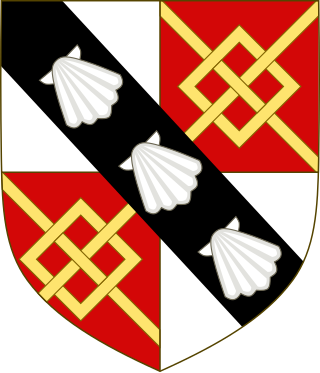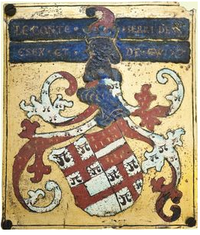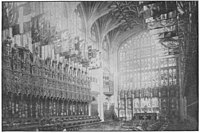
Thomas Boleyn, Earl of Wiltshire, 1st Earl of Ormond, 1st Viscount RochfordKGKB, of Hever Castle in Kent, was an English diplomat and politician who was the father of Anne Boleyn, the second wife of King Henry VIII, and was thus the maternal grandfather of Queen Elizabeth I. By Henry VIII he was made a knight of the Garter in 1523 and was elevated to the peerage as Viscount Rochford in 1525 and in 1529 was further ennobled as Earl of Wiltshire and Earl of Ormond.

The Most Noble Order of the Garter is an order of chivalry founded by Edward III of England in 1348. The most senior order of knighthood in the British honours system, it is outranked in precedence only by the decorations of the Victoria Cross and the George Cross. The Order of the Garter is dedicated to the image and arms of Saint George, England's patron saint.

The Spencer family is an aristocratic family in the United Kingdom. From the 16th century, its members have held numerous titles, including the dukedom of Marlborough, the earldoms of Sunderland and Spencer, and the Churchill barony. Two prominent members of the family during the 20th century were Sir Winston Churchill and Diana, Princess of Wales.

The Most Illustrious Order of Saint Patrick is a dormant British order of chivalry associated with Ireland. The Order was created in 1783 by King George III at the request of the then Lord Lieutenant of Ireland, The 3rd Earl Temple. The regular creation of knights of the Order lasted until 1922, when most of Ireland gained independence as the Irish Free State, a dominion within what was then known as the British Commonwealth of Nations. While the Order technically still exists, no knight of St Patrick has been created since 1936, and the last surviving knight, Prince Henry, Duke of Gloucester, died in 1974. Charles III, however, remains the Sovereign of the Order, and one officer, the Ulster King of Arms, also survives. St Patrick is patron of the order; its motto is Quis separabit?, Latin for "Who will separate [us]?": an allusion to the Vulgate translation of Romans 8:35, "Who shall separate us from the love of Christ?"

The Most Ancient and Most Noble Order of the Thistle is an order of chivalry associated with Scotland. The current version of the order was founded in 1687 by King James VII of Scotland, who asserted that he was reviving an earlier order. The order consists of the sovereign and sixteen knights and ladies, as well as certain "extra" knights. The sovereign alone grants membership of the order; they are not advised by the government, as occurs with most other orders.

Earl of Shrewsbury is a hereditary title of nobility created twice in the Peerage of England. The second earldom dates to 1442. The holder of the Earldom of Shrewsbury also holds the title of Earl of Waterford (1446) in the Peerage of Ireland and Earl Talbot (1784) in the Peerage of Great Britain. Shrewsbury and Waterford are the oldest earldoms in their peerages held by someone with no higher title, and as such the Earl of Shrewsbury is sometimes described as the premier earl of England and Ireland.

Earl Cadogan is a title that has been created twice in the Peerage of Great Britain for the Cadogan family. The second creation, in 1800, was for Charles Cadogan, 3rd Baron Cadogan.

Baron Stafford, referring to the town of Stafford, is a title that has been created several times in the Peerage of England. In the 14th century, the barons of the first creation were made earls. Those of the fifth creation, in the 17th century, became first viscounts and then earls. Since 1913, the title has been held by the Fitzherbert family.

Thomas Manners, 1st Earl of Rutland, 12th Baron de Ros of Helmsley, KG, of Belvoir Castle in Leicestershire, was created Earl of Rutland by King Henry VIII in 1525.

James Stanley, 7th Earl of Derby, KG was an English nobleman, politician, and supporter of the Royalist cause in the English Civil War. Before inheriting the title in 1642 he was known as Lord Strange. He was feudal Lord of the Isle of Man, where he was known as "Yn Stanlagh Mooar".

John Talbot was the 2nd Earl of Shrewsbury, 2nd Earl of Waterford, 8th Baron Talbot, KG was an English nobleman and soldier and the son of John Talbot, 1st Earl of Shrewsbury, 1st Earl of Waterford, 7th Baron Talbot, 10th Baron Strange of Blackmere, and Maud Neville, 6th Baroness Furnivall.

Henry Bourchier, 5th Baron Bourchier, 2nd Count of Eu, 1st Viscount Bourchier, 1st Earl of Essex, KG, was the eldest son of William Bourchier, 1st Count of Eu, and Anne of Gloucester. On his mother's side, he was a great-grandson of Edward III of England.

John Bourchier, 1st Baron Berners, KG was an English peer.
Anne Bourchier was the suo jure7th Baroness Bourchier, suo jureLady Lovayne, and Baroness Parr of Kendal. She was the first wife of William Parr, 1st Marquess of Northampton, Earl of Essex, and the sister-in-law of Catherine Parr, the sixth wife of Henry VIII of England.

St George's Chapel at Windsor Castle in England is a castle chapel built in the late-medieval Perpendicular Gothic style. It is a Royal Peculiar, and the Chapel of the Order of the Garter. St George's Chapel was founded in the 14th century by King Edward III and extensively enlarged in the late 15th century. It is located in the Lower Ward of the castle.

The historical monographs relating to St George's Chapel, Windsor Castle are a series of scholarly publications supported by the Dean and Canons of Windsor. Much of the scholarship is based on the material held in the archives at St. George’s Chapel, Windsor Castle.

In heraldry, an achievement, armorial achievement or heraldic achievement is a full display or depiction of all the heraldic components to which the bearer of a coat of arms is entitled. An achievement comprises not only the arms displayed on the escutcheon, the central element, but also the following elements surrounding it :

Sir Thomas Wale was an English soldier and founder Knight of the Garter.

The feudal barony of Bampton was one of eight feudal baronies in Devonshire which existed during the mediaeval era, and had its caput at Bampton Castle within the manor of Bampton.

Sir William Arundel KG was a Knight of the Order of the Garter, Constable of Rochester Castle and Constable and Warden of Reigate Castle. He owed all his appointments to Richard II whose reign (1377-1399) covered most of Arundel's life.


























